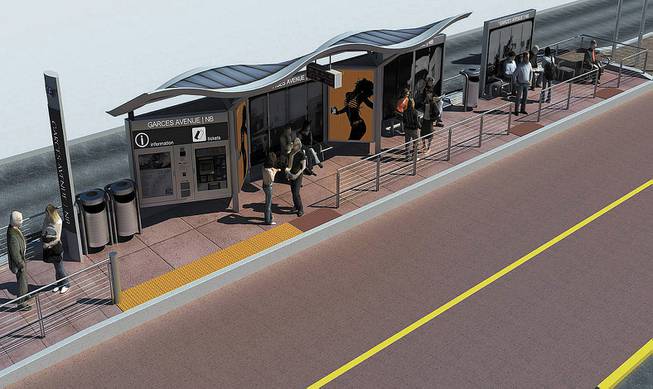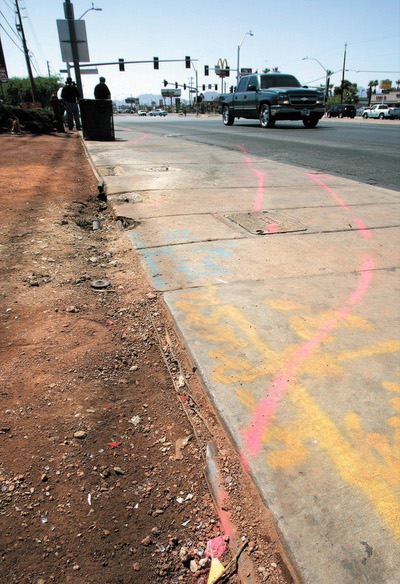
Regional Transportation Commission of Southern Nevada
An artist’s rendering shows a bus shelter enclosed by barriers. It is one of several measures being considered by the Regional Transportation Commission to increase safety.
Wednesday, July 9, 2008 | 2 a.m.
Sun Archives
- Driver arrested in bus stop crash that kills one, injures another (7-7-2008)
- Valley has seen share of similar crashes (3-15-2005)
- Crash at bus stop kills 4 (3-14-2005)
- Boy, 4, killed at bus stop (3-4-2004)
By 10 a.m. Monday, the broken skeleton of the bus stop had been carted away. And there was nothing left to indicate a woman had been fatally struck there five hours earlier, when the driver of a large pickup truck lost control and plowed into her.
“Hey, is there still going to be a bus stop here?” a security guard from the nearby motel said.
Metro Detective William Redfairn nodded that, yeah, it’ll be back.
What Redfairn, a veteran traffic accident investigator, didn’t say was that he figures there’s little that can be done to prevent another vehicle from mowing down the replacement or any of the county’s 2,016 other bus shelters.
“I don’t think anybody has the answer,” he told the Sun.
Efforts to find a solution continue nonetheless. The Regional Transportation Commission is studying ideas, including the possibility of installing bollards — concrete posts — around some bus shelters or locating bus stops behind utility poles. In addition, state Sen. John Lee, D-North Las Vegas, who pushed a related measure through the Legislature in 2007, plans to push a new bill next year that he believes will make bus stops safer.
It’s an increasingly important goal, Lee said, as rising gas prices continue to turn more commuters into bus riders.
From January to May of this year, 700,000 more riders took the bus in Clark County than in 2007. And in 2007, 1.1 million more took the bus than in 2006.
Meanwhile, the latest statistics from the Nevada Transportation Department show that in 2006, 7,461 crashes involved vehicles hitting stationary, off-road objects. That was 12.2 percent of all crashes that year. It was also nearly double the 3,743 crashes of the same kind just three years earlier.
Of the 2003 accidents, only 25 reportedly involved bus shelters. Similar numbers for 2006 were not available. But if the same percentage of crashes involving bus stops in 2003 held for 2006, the number in 2006 would have been about 50.
Deaths from those accidents are rare. But they almost always make headlines.
• In March 2005, Veronica Schmidt plowed her Ford Explorer SUV into a bus stop at Smoke Ranch and Rock Springs roads. Killed were Raquel and Angelica Jimenez, 16 and 14, along with Samantha Allen, 36, and Reginald Williams, 16. Schmidt was placed under eight months of house arrest, but was sentenced to 180 days in jail in December 2007 because she failed to complete 60 hours of community service and pay $5,000 in court fees and fines.
• In May 2004, Nicolas Serrano-Villagrana killed 4-year-old Eulogia Avendano and injured two others when he hit them at a shelter at Eastern Avenue and U.S. 95. He was sentenced to 12 to 40 years in prison after convictions on three counts of felony driving under the influence causing substantial bodily harm.
• On Christmas Day 2003, Bruce L. Kirton, 49, died after a vehicle ran a red light, struck a car and hit Kirton at a bus stop.
• In October 2002, John Wan, 50, died standing at a bus shelter near Charleston Boulevard and Fremont Street when a drunken driver hit him in a pickup truck.
Crashes at bus stops, whether deadly or involving only property damage, have been an issue for the Regional Transportation Commission for years.
And though lawsuits are always possible, RTC General Manager Jacob Snow said in a recent interview liability isn’t the big concern.
“It’s simply public safety,” he said.
For years, the RTC was largely powerless to do anything because the bus stops fell within the domain of local municipalities. In 2005, however, the Legislature turned over control to the RTC. And in 2006, the RTC signed a contract with Outdoor Promotions to handle maintenance, construction and installation of bus shelters.
But that doesn’t mean the RTC abrogates all responsibility for safety. In April, Snow gave a report to the RTC’s Bus Shelter and Bus Advisory Committee that included the cost to install bollards at the 2,016 bus stops in the county that have shelters or benches. With four bollards per stop at $1,500 each, the cost to the RTC, not Outdoor Promotions, would be $12.1 million.
But there are problems with the bollards idea beyond the cost.
In Clark County, sidewalks are often poured right up to the curb, leaving scant feet between traffic and pedestrians. Bus stops play into the potential danger; they are often anchored to the sidewalk just a few feet from the curb. The fear is that bollards would so cramp the space that sidewalks would be impassable to some people with disabilities.
Lee also pointed out that studies show vehicles hitting a bollard at 45 mph or faster may be stopped, but the impact can send pieces of the concrete and vehicle into the people the barrier is meant to protect.
Placing shelters and bus benches behind utility poles, which could act as barriers, is an alternative measure the RTC is reviewing.
But Lee believes the most effective measure is to move bus stops as far back from the road as possible.
“I want to get those people farther back (from the road),” Lee said. “We’ve got to build that idea into the system.”
To that end, he introduced and passed legislation in 2007 allowing the placement of bus shelters on public property, including public easements dedicated to utilities. In essence, that allows many shelters to be pushed behind sidewalks. Since then, 86 shelters have been moved back, behind sidewalks and farther from the road, Snow said.
“It was a start,” Lee said this week.
He wants to take the idea further in 2009. He will introduce a bill to encourage public entities and utilities with bus stops near their facilities to allow for the construction of bus “turn outs.” Turn outs are short spaces at shelters that allow a bus to get off the main lanes of a roadway while picking up and dropping off passengers.
Lee isn’t sure how his measure will stand up, admitting that some lawmakers will see it as akin to “a taking” of property because it will require eating up more right-of-way space.
“I just think it’s the right thing to do, and if we show private companies that our public entities are doing it, maybe they will follow suit and do the same,” he said.
•••
In the case of Monday’s death following the Flamingo Road and Boulder Highway crash, Lee’s best defense against those accidents was already in place. The bus stop was behind the sidewalk, a good 5 feet from the road. And there was a utility pole about 20 feet to the side of the shelter, in the path of the pickup truck.
Neither mattered.
Fluorescent pink spray paint marked the curved path traveled by 44-year-old Steven Murray’s truck. Past the utility pole, Murray’s truck suddenly swerved right, jumped the curb and hit two people. Patricia Ann Hoff, 51, died from her injuries; Porshe Hughes, 26, was critically injured. Murray was arrested on a felony charge of driving under the influence. Police believe prescription drugs might have been involved.
Hoff’s daughter, Robin Wynkoop of Las Vegas, said her mother worked at a nearby Lowe’s and had been living in the Budget Suites motel behind the bus stop for about a month.
“She was living there so she could help me out with my bills,” Wynkoop said, beginning to cry.
But as to what could been done to prevent the death of Wynkoop’s mother, Redfairn, who has investigated traffic deaths for years, took a fatalist’s view.
“The only explanation I have is: This is God’s plan,” he said. “What other logical explanation is there?”


Join the Discussion:
Check this out for a full explanation of our conversion to the LiveFyre commenting system and instructions on how to sign up for an account.
Full comments policy